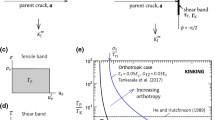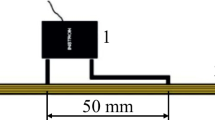Abstract
Cohesive-zone models have been successfully applied to predicting the damage from notches in engineering materials loaded intension. They have also been used to determine the growth of fibre microbuckling from a hole in a composite laminate under compression. The usual strategy is to replace the in elastic deformation associated with plasticity or microbuckling with a line crack and to assume some form of stress-displacement bridging law across the crack faces. This paper examines recent published experimental data for notched glass-fibre epoxy/honey comb sand wich panels loaded in uniaxial compression. A plastic fibre kinking analysis and a linear softening cohesive-zone model are used for the prediction of the unnotched and open-hole compressive strength and the theoretical results are found to be in a good agreement with experimental data.
Similar content being viewed by others
References
C. Soutis, N. A. Fleck, and P. A. Smith, “Failure prediction technique for compression loaded carbon fibre-epoxy laminate with an open hole,” J. Compos. Mater., 25, 1476–1498 (1991).
C. Soutis, P. T. Curtis, and N. A. Fleck, Compressive failure of notched carbon fibre composites, Proc. Roy. Soc. Lond. A, 440, 241–256 (1993).
X. J. Xin, P. P. F. Sutcliffe, N. A. Fleck, and P. T. Curtis, “Composites Compressive Strength Modeller,” Cambridge University Engineering Department, CUED MAT/TR139, (1995).
B. W. Rosen, “Mechanics of composites strengthening.” in: Fiber Composite Materials, American Society of Metals Seminar Ch. 3, ASM, Ohio (1965), pp. 37–75.
B. Budiansky, “Micromechanics,” Comput. and Struct., 16, No. 1, 3–12 (1983).
D. S. Dugdale, “Yielding of steel sheets containing slits,” J. Mech. Phys. Solids, 8, 100–104 (1960).
C. Soutis and P. T. Curtis, “A method for predicting the fracture toughness of CFRP laminates failing by fire microbuckling,” Composites, Pt. A, 31, No. 7, 733–740 (2000).
B. A Smith, “Air frames stress durability in composites,” Aviat. Week Space Technol., 142, 60–61 (1995).
R. Abbot, “Damage tolerance evaluation of composite honey comb structures,” in: International SAMPE Symposium and Exhibition (Proc.), 43, SAMPE, Covina, CA, USA (1998), pp. 376–386.
M. G. Toribio, J. M. Mirazo, and S. M. Spearing, “On the compressive response of notched composite-honeycomb sandwich panels,” AIAA Paper 99-1415, Presented at AIAA SDM Meeting, St. Louis (April, 1999).
M. G. Toribio and S. M. Spearing, “Compressive response of notched glass-fiber/honeycomb sandwich panels,” Composites, Pt. A, 32, 859–870 (2001).
F. Edgren, “Compressive failure of NCF composites,” in: Proc. American Society for Composites, 12th Technical Conference, Drexel University Philadelphia, USA (2005).
Author information
Authors and Affiliations
Additional information
Russian translation published in Mekhanika Kompozitnykh Materialov, Vol. 43, No. 1, pp. 73–84, January–February, 2007.
Rights and permissions
About this article
Cite this article
Soutis, C. A fibre microbuckling model for predicting the notched compressive strength of composite sandwich panels. Mech Compos Mater 43, 51–58 (2007). https://doi.org/10.1007/s11029-007-0005-3
Received:
Issue Date:
DOI: https://doi.org/10.1007/s11029-007-0005-3




